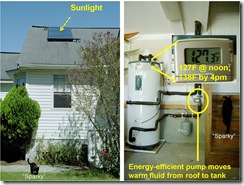For the water heater, we need some additional information, namely, your water bill. Similar to energy, you’ll need to divide the total consumption (gallons) by the number of days in the billing cycle to estimate daily usage, which should also then be visually examined across 12-24+ months for seasonal usage patterns. The purpose of examining water consumption trends across seasons and years is to distinguish baseline consumption from seasonal loads that often involve outdoor activities that by-pass the hot water heater.
Once you have an estimate of baseline water consumption data, you’ll need to determine how much of that load represents hot water. For showers, an easy way to measure flow rate is to fill up a pitcher of known volume and count the number of seconds required to fill it. Similarly, use the temperature handle settings to estimate what percent of the flow is hot water (i.e., if the normal flow rate is achieved by two turns of the hot and one turn of the cold knob, ~67% of the water is hot). For bath tubs, calculate the volume of water based on the appropriate geometric shape of the tub and estimate how much of each bath is associated with hot water. And don’t forget the sink faucets, clothes washer and dishwasher if applicable.
 Once you know the volume of hot water that ‘turns over’ daily, you can use the chart to the left and the formula below to estimate the amount of energy needed to heat that water to your desired water heater thermostat setting each day.
Once you know the volume of hot water that ‘turns over’ daily, you can use the chart to the left and the formula below to estimate the amount of energy needed to heat that water to your desired water heater thermostat setting each day.
Water Heating Requirements: KW = (0.002442) x (gallons of water) x (°F change in temp)
Assume that incoming water temperature is comparable to ground water temperature (~70°F) for most of the year, but recognize that it may be considerably colder during winter depending on your plumbing (which can be mitigated with pipe insulation). It is also a good idea to use a thermometer to compare the temperature of hot water exiting faucets with the water heater thermostat setting, though recognizing that a slight amount of heat loss should be expected.
The calculation above is simply the energy requirement to initially heat the replacement water in the water heater. Because standing water loses heat over time, additional energy is needed to maintain that temperature each day. How much maintenance energy is needed each day depends on well the water heater is insulated from cold air pockets that encourage heat loss, but for the purposes of the audit I recommend doubling the heat replacement requirement to represent a conservative estimate of daily replacement plus maintenance energy requirements.
 Low-cost, no-cost ways to reduce your hot water demand include lowering your thermostat setting (free!) and purchasing water heater blankets and operational timers to reduce maintenance heat requirements. Heat-on-demand systems eliminate standing water maintenance energy needs. Solar-thermal heating systems (~$3.5k after tax breaks) save energy by reducing the heat differential between starting and desired ending water temperatures by pre-heating your water supply before it enters a fossil-fuel powered water heater. Solar-thermal systems are amazingly efficient and my system has reduced my hot water demand by about 90% annually because it allows me to turn my electric hot water heater OFF at the breaker between mid-March and mid-November as well as supplies about 70% of the BTUs needed to heat my water to 105°F during the rest of the year.
Low-cost, no-cost ways to reduce your hot water demand include lowering your thermostat setting (free!) and purchasing water heater blankets and operational timers to reduce maintenance heat requirements. Heat-on-demand systems eliminate standing water maintenance energy needs. Solar-thermal heating systems (~$3.5k after tax breaks) save energy by reducing the heat differential between starting and desired ending water temperatures by pre-heating your water supply before it enters a fossil-fuel powered water heater. Solar-thermal systems are amazingly efficient and my system has reduced my hot water demand by about 90% annually because it allows me to turn my electric hot water heater OFF at the breaker between mid-March and mid-November as well as supplies about 70% of the BTUs needed to heat my water to 105°F during the rest of the year.
Click here for lighting and smaller electrical appliance mitigation
